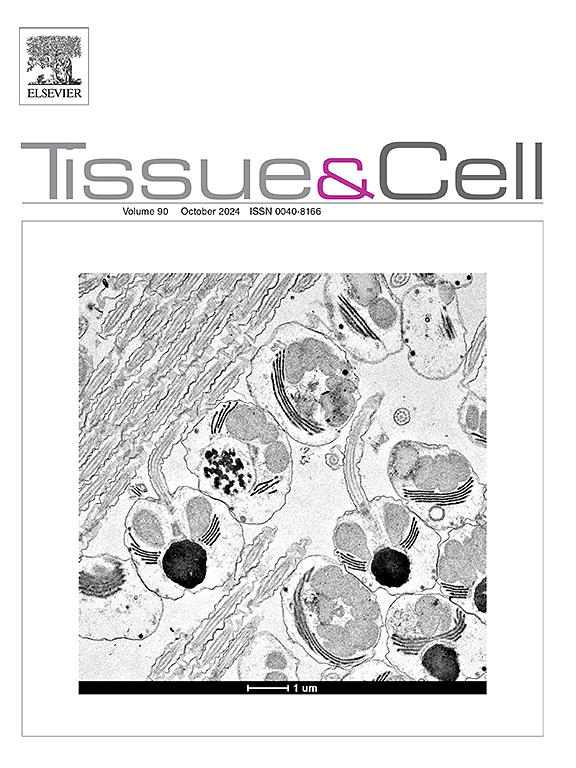Protocol for the generation and analysis of organoids from Dental pulp stem cells (DPSCs)
IF 2.7
4区 生物学
Q1 ANATOMY & MORPHOLOGY
引用次数: 0
Abstract
DPSCs are a valuable resource for creating three-dimensional (3D) in vitro models, such as organoids, due to their accessibility and differentiation potential. Organoids have revolutionized in vitro culture, thanks to their ability to more faithfully replicate the architecture and complexity of tissues compared to 2D cultures. This enables their use in a wide range of applications, including research on genetic diseases, innovative therapies, and tissue engineering. This project aims to establish an in vitro protocol for generating 3D models from DPSCs to study dental diseases and test new drugs for regenerative medicine and tissue reconstruction. To this end, the organoids underwent morphological, viability, and functional analyses, allowing us to evaluate the effectiveness of the protocol and the validity of the model. The protocol includes the culture of DPSCs in Matrigel® Matrix, an extracellular matrix that supports 3D-fabricated organoids formation and growth. These 3D structures are exposed to differentiation factors to generate dental pulp organoids. However, the presence of Matrigel® Matrix may interfere with subsequent molecular analyses. To overcome this limitation, an efficient method for removing the Matrigel® Matrix was developed to allow efficient extraction of nucleic acids and proteins. Immunohistochemical and immunofluorescence techniques were also optimized to visualize cellular structures and markers. Cell count and proliferation were assessed using a CCK-8 viability assay, as well as Trypan Blue staining. The feasibility and effectiveness of this protocol can provide a new tool for studying dental pulp biology, paving the way for future applications in the field of dental pulp regeneration research.
牙髓干细胞(DPSCs)类器官的生成和分析方法
由于其可及性和分化潜力,DPSCs是创建三维(3D)体外模型(如类器官)的宝贵资源。与2D培养相比,类器官能够更忠实地复制组织的结构和复杂性,这使体外培养发生了革命性的变化。这使得它们的应用范围很广,包括研究遗传疾病、创新疗法和组织工程。该项目旨在建立一种从DPSCs生成3D模型的体外方案,用于研究牙科疾病,并测试用于再生医学和组织重建的新药。为此,对类器官进行形态学、活力和功能分析,使我们能够评估方案的有效性和模型的有效性。该方案包括在Matrigel®Matrix中培养DPSCs,这是一种支持3d制造类器官形成和生长的细胞外基质。这些三维结构暴露于分化因子中生成牙髓类器官。然而,Matrigel®Matrix的存在可能会干扰随后的分子分析。为了克服这一限制,开发了一种有效的去除Matrigel®Matrix的方法,以有效地提取核酸和蛋白质。免疫组织化学和免疫荧光技术也进行了优化,以显示细胞结构和标记物。使用CCK-8活力测定和台盼蓝染色评估细胞计数和增殖。该方案的可行性和有效性为牙髓生物学研究提供了新的工具,为今后在牙髓再生研究领域的应用铺平了道路。
本文章由计算机程序翻译,如有差异,请以英文原文为准。
求助全文
约1分钟内获得全文
求助全文
来源期刊

Tissue & cell
医学-解剖学与形态学
CiteScore
3.90
自引率
0.00%
发文量
234
期刊介绍:
Tissue and Cell is devoted to original research on the organization of cells, subcellular and extracellular components at all levels, including the grouping and interrelations of cells in tissues and organs. The journal encourages submission of ultrastructural studies that provide novel insights into structure, function and physiology of cells and tissues, in health and disease. Bioengineering and stem cells studies focused on the description of morphological and/or histological data are also welcomed.
Studies investigating the effect of compounds and/or substances on structure of cells and tissues are generally outside the scope of this journal. For consideration, studies should contain a clear rationale on the use of (a) given substance(s), have a compelling morphological and structural focus and present novel incremental findings from previous literature.
 求助内容:
求助内容: 应助结果提醒方式:
应助结果提醒方式:


